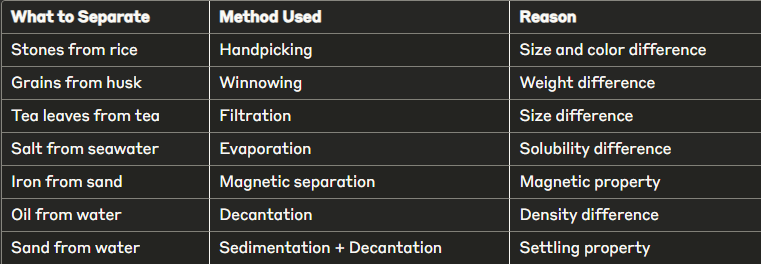Summary
Quick Revision Table:

Key Learning Outcomes:
- Understanding different separation methods
- Identifying appropriate method for given mixture
- Real-life applications of separation techniques
- Environmental and economic importance
🧠 Real-Life Applications
In Agriculture:
- Threshing and Winnowing: Grain processing
- Sieving: Cleaning seeds
- Handpicking: Sorting vegetables
In Kitchen:
- Filtration: Tea/coffee preparation
- Decantation: Separating oil from water
- Sieving: Flour preparation
- Evaporation: Making concentrated syrups
In Industry:
- Magnetic separation: Recycling metals
- Filtration: Water treatment plants
- Distillation: Petroleum refining
- Evaporation: Chemical processing
In Water Treatment:
- Sedimentation: Settling impurities
- Filtration: Removing bacteria and particles
- Chlorination: Killing germs
- Reverse osmosis: Advanced purification
🧪 Important Points to Remember
🔸 Choice of Method depends on:
- Type of mixture (solid-solid, solid-liquid, liquid-liquid)
- Properties of components (size, weight, solubility, magnetic nature)
- Quantity of mixture
- Available equipment
🔸 Combined Methods:
- Often multiple methods are used together
- Example: Threshing → Winnowing → Sieving
🔸 Traditional vs Modern:
- Traditional methods are eco-friendly
- Modern methods are faster and more efficient
- Both have their importance
